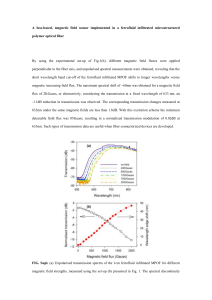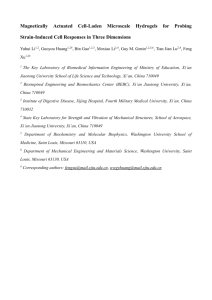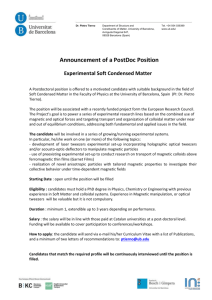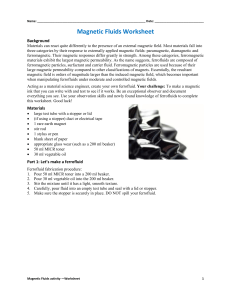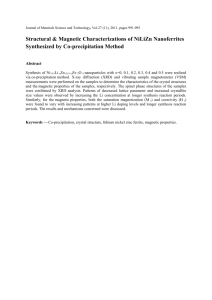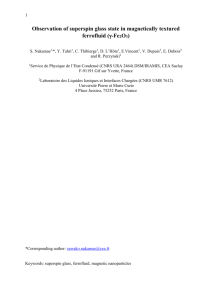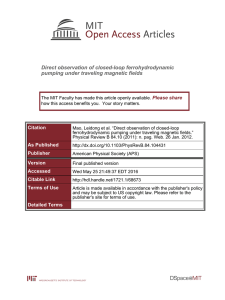Electric field-induced instabilities in ferrofluid microflows
advertisement
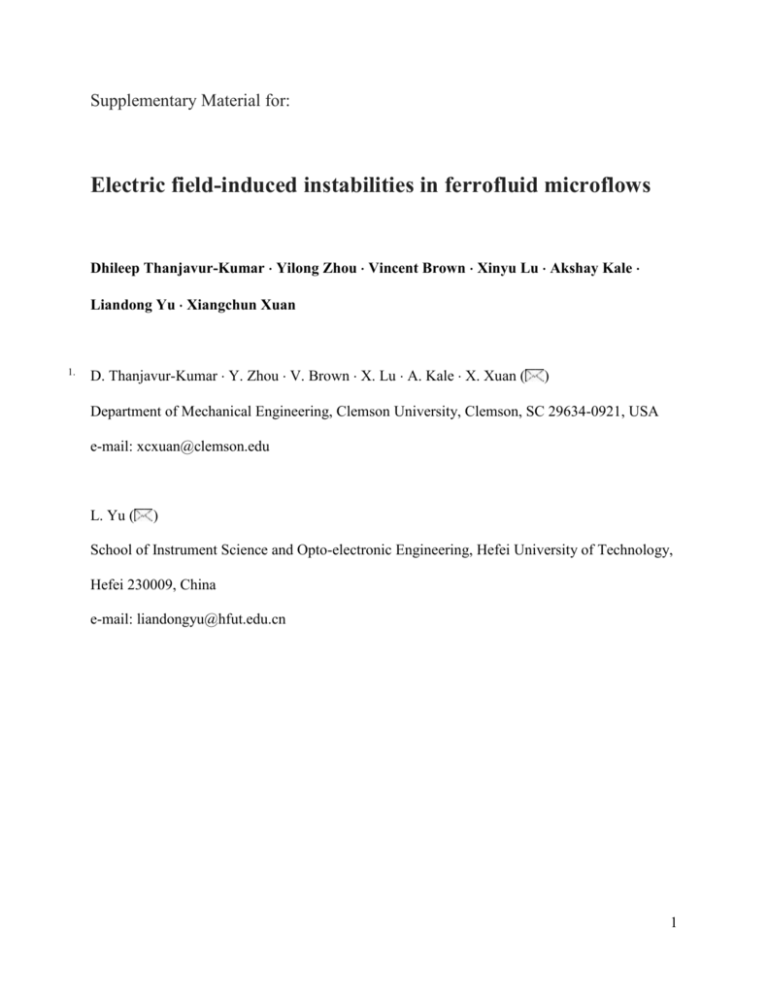
Supplementary Material for: Electric field-induced instabilities in ferrofluid microflows Dhileep Thanjavur-Kumar Yilong Zhou Vincent Brown Xinyu Lu Akshay Kale Liandong Yu Xiangchun Xuan 1. D. Thanjavur-Kumar Y. Zhou V. Brown X. Lu A. Kale X. Xuan ( ) Department of Mechanical Engineering, Clemson University, Clemson, SC 29634-0921, USA e-mail: xcxuan@clemson.edu L. Yu ( ) School of Instrument Science and Opto-electronic Engineering, Hefei University of Technology, Hefei 230009, China e-mail: liandongyu@hfut.edu.cn 1 S1 Effect of ferrofluid (magnetic nanoparticle) electrophoresis Particles in contact with an aqueous solution acquire charges on their surface that result in the formation of an electric double layer (EDL). Under the application of a DC electric field the particles have a tendency to migrate towards the oppositely charged electrode, which is called electrophoresis (Li 2004). The net motion of particle is due to the vector addition of fluid electroosmosis and particle electrophoresis. The electrophoretic component of particle velocity is given by Eq. (S1) (Li 2004). 𝐔𝑒𝑝 = 𝜀𝜁𝑝 𝜇 𝐄 = 𝜇𝑒𝑝 𝐄 (S1) where 𝐔𝑒𝑝 is the electrophoretic velocity, 𝜀 is the permittivity of fluid, 𝜁𝑝 is the particle zeta potential, 𝐄 is the electric field, 𝜇 is the viscosity of fluid, and 𝜇𝑒𝑝 is the electrophoretic mobility. The zeta potential values for magnetic nanoparticles are not available and hence a parametric study assuming a range of zeta potential values was conducted to understand the effect of electrophoretic behavior of nanoparticles on the threshold electric field for electrokinetic instability. The model presented in the main text considers the zeta potential of particles to be zero and hence the electrophoretic velocity component is zero. In the current model the electrophoretic velocity from Eq. (S1) was fed into the conservative form of the convectiondiffusion equation since it is divergence free (Ivory and Srivastava 2011), i.e., 𝜕𝑐 𝜕𝑡 + 𝐮 ∙ ∇𝑐 + ∇ ∙ (𝑐𝜇𝑒𝑝 𝐄) = 𝐷∇2 c (S2) 0.3 EMG 408 ferrofluid was chosen for this parametric study. A series of simulations were carried out by varying the zeta potential of magnetic nanoparticles from -50 mV to 100 mV at an increment of 10 mV. A negative particle zeta potential represents the movement of nanoparticles against the electroosmotic fluid flow whereas a positive value signifies the movement along with the fluid flow. Simulations for zeta potentials less than -20 mV resulted in a much lesser flow 2 rate of ferrofluid and values more than 40 mV showed a much higher flow rate. Those trends were contrary to the experimental observations and hence values from -20 mV to 40 mV were considered for the current study. The threshold electric fields obtained from simulations for different values of particle zeta potentials are shown in Fig. S1. They decrease as the zeta potential is increased from -20 mV, reaches a minimum around 25 mV, and then increases again. However, the maximum change in the predicted threshold electric field on either side of 0 mV is only around 8%, which is insignificant compared to the discrepancy between the experimental and simulation results show in Fig. 9 in the main text. Threshold electric field (V/cm) 94 92 90 88 86 84 82 80 78 -30 -20 -10 0 10 20 30 40 50 Zeta potential of magnetic nanoparticles in ferrofluid (mV) Fig. S1: Variation of the numerically predicted threshold electric field for electrokinetic instabilities in 0.3 ferrofluid/water co-flow at different values of assumed zeta potential of magnetic nanoparticles. S2 Effect of ferrofluid (magnetic nanoparticle) magnetophoresis The DC voltage difference between the inlet and outlet reservoirs of the microchannel results in electric current flows through both the ferrofluid and water, which can generate a magnetic field inside and outside the microchannel. Ferrofluids will respond to this magnetic field, which, 3 however, was ignored in the numerical model presented in the main text. Here, we do an estimation of the magnetic field and as well the magnetophoretic force imparted on nanoparticles. Since the maximum current density was encountered in 0.3 EMG 408 ferrofluid, this concentration was chosen for the parametric study. In reality the magnetic field generated is three-dimensional. To reduce the computational requirement and to get only an estimate of the magnetic field, a two-dimensional model was considered. An arbitrary cross-section of microchannel in the main channel was modeled in COMSOL along with air space around the section as shown in Fig. S2. Fig. S2: Schematic representation of the cross-section of the main-branch in the tested T-shaped microchannel that was modeled with a surrounding air box in COMSOL. To simplify the analysis, a base state before the start of electroosmotic flow was considered for this study, where ferrofluid occupies the left half of microchannel and water in the right half as shown in Fig. S2. Magnetic field was obtained by solving Eq. (S3) and Eq. (S4) in COMSOL 4 using the values listed in Table. S1. Magnetic insulation was specified along the outer edges of the air box. ∇×𝐇 =𝐉 (S3) 𝐁= ∇×𝐀 (S4) where H is the magnetic field, J is the current density, B is the magnetic flux and A is the magnetic potential. The current density was obtained by multiplying the threshold electric field with the corresponding conductivities of ferrofluid and water. Default stationary solver was used. Fig. S3 shows the contour plot of magnetic field magnitude generated due to the current flowing through both fluids, where the magnetic field values are the maximum near the walls of the microchannel and decrease on either side. Properties Air Water 0.3 Electrical conductivity (S/m) 0 29.5e-4 1615e-4 Relative Relative Current density permittivity permeability (A/m2) 1 1 0 80 1 25.11 80 1.15 1375.17 Table. S1: Parameters used for the simulation of ferrofluid magnetophoresis effects Fig. S3: Contour plot of the electric current-generated magnetic field (A/m) over the 2D computational domain in Fig. S2. 5 The magnetic force per unit volume experienced by the nanoparticles because of the induced magnetic field was quantified using Eq. (S5) (Watarai et al. 2004). 𝐅𝑚 = 𝜇0 (𝜒𝑝 − 𝜒𝑤 )(𝐇 ∙ ∇)𝐇 (S5) where 𝐅𝑚 is the magnetic force vector, 𝜇0 is the permeability of free space ( = 1.256e-6 H/m), 𝜒𝑝 is the susceptibility of particles (≈ 1), and 𝜒𝑤 is the susceptibility of water (≈ 0). The magnetophoretic force per unit volume that the nanoparticle will experience was calculated for the region within the microchannel as shown in Fig. S4. It is found to be on the order of 1e-5 N/m3 which is many orders of magnitude smaller than the electrical body force experienced by the liquids (on the order of 100 N/m3 as viewed from Fig. 8(C) in the main text). Hence the magnetophoretic force experienced by the magnetic nanoparticles will not have a significant effect on the threshold electric field. Fig. S4: Contour plot of the electric current-induced magnetic force per unit volume (N/m3) experienced by magnetic nanoparticles in 0.3 ferrofluid. References 6 Ivory CF, Srivastava SK (2011) Direct current dielectrophoretic simulation of proteins using an array of circular insulating posts. Electrophoresis 32:2323-2330 Li D (2004) Electrokinetics in microfluidics. Academic Press Watarai H, Suwa M, Iiguni Y (2004) Magnetophoresis and electromagnetophoresis of microparticles in liquids. Anal Bioanal Chem 378:1693-1699 7
